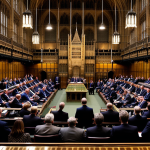Understanding the Importance of Natural Light in Art Studios
Natural light plays a significant role in creating an inspiring and functional art studio design. It not only enhances the aesthetic allure of the space but also boosts creativity and mood. Artists often find that natural light improves their ability to perceive colours accurately, leading to better quality artwork and a more cohesive creative workspace.
The benefits of natural light extend beyond artistry. It is linked to various health advantages, including improved mood and increased vitamin D absorption. Regular exposure can positively affect mental health by reducing stress and improving overall well-being. This is particularly beneficial for artists who spend long hours in their studios and require a conducive environment to remain productive.
Also to discover : Maximizing storage in small apartments: creative solutions for space efficiency
Moreover, the presence of natural light transforms the studio ambiance. It creates a warm, inviting atmosphere that fosters artistic expression and innovation. Art studios designed with an emphasis on natural light often have large windows or skylights, which allow artists to take full advantage of daylight. This not only hones their craft but also promotes a sense of connection with the natural world outside, further enriching their creative experience.
Assessing Your Basement’s Potential for Natural Light
Evaluating your basement’s potential for natural light involves a basement lighting assessment to understand how sunlight can enter. First, observe existing natural light sources such as windows or external doors. The presence of these openings can serve as primary natural light points.
Also to see : Transform your home with skylights for pitched roofs
Next, inspect the studio layout to determine how the light flows in the space. Aim to position work areas where they receive the most beneficial light. Rearranging furniture or equipment might be necessary to optimise this flow. In basements with limited light access, make consistent notes detailing where shadows form and which areas need better illumination throughout the day.
Identifying any obstructions, like heavy furniture blocking light paths, is crucial. You might discover small opportunities to cut or remove elements that cast unnecessary shadows. Consider the potential for adding windows or light tubes for improved access, which require evaluating your basement’s structure. Assessing these elements not only prepares your area for art studio conversion but also ensures that every corner of your workspace is illuminated efficiently and effectively.
Creative Solutions for Enhancing Natural Light
Enhancing natural light in your art studio can transform an ordinary space into an extraordinary one.
Incorporating Reflective Surfaces
Reflective surfaces offer a straightforward method to maximize light. Mirrors strategically placed can significantly brighten darker areas by bouncing light across the room. Choose glossy paint finishes for walls and ceilings, which can further amplify this effect. Additionally, light-colored furniture and decor will reflect more light, enhancing the overall illumination of the studio.
Installing Light Tubes or Skylights
Installing light tubes or skylights can revolutionize how light enters a basement studio. Light tubes are an innovative solution, capturing sunlight from the roof and channeling it indoors. When selecting skylights, consider options like fixed or vented, aligning with your studio requirements. It’s vital to position them correctly to take full advantage of sunlight throughout the day for optimal light entry.
Choosing the Right Window Treatments
For windows, opt for sheer curtains or blinds, which allow ample light while providing privacy. This technique controls glare efficiently. Avoid heavy drapery, as it can absorb light and diminish the bright ambiance you’re aiming to achieve. Embracing these practices ensures a brightly lit, inspiring workspace.
Designing Your Ideal Art Studio Layout
Creating an optimal studio layout is crucial for maximising both light usage and space. Begin by strategically arranging furniture to facilitate the flow of natural light. This can involve placing worktables near windows or light sources and using low-profile or movable furniture that does not impede light paths.
Creating defined zones within your studio enhances functionality. Designate specific areas for various artistic tasks, such as painting, sculpting, or digital work. This space optimisation ensures that each task benefits from the appropriate lighting conditions and tools without overlap. For instance, a painting zone might be positioned to receive direct sunlight, while a digital workspace could be placed further away to reduce glare on computer screens.
Incorporate flexible workspaces that can adapt to changing lighting throughout the day. Consider using adjustable desks or easels that allow for easy repositioning in response to light shifts. This adaptability ensures that you maintain an effective workspace regardless of the time of day or weather conditions. By focusing on thoughtful furniture arrangement, your art studio will become a versatile and inspiring creative haven.
Implementing Innovative Lighting Fixtures
Integrating innovative lighting fixtures in an art studio enhances functionality and ambience. It allows artists to maintain optimal light levels regardless of external conditions. Thoughtfully designed fixtures also add a layer of aesthetic finesse to any creative space.
Selecting LED Lighting Options
LED lights are a popular choice for studios due to their energy efficiency and lifespan. Offering a deeper light spectrum, they help in accurately representing paint colours and textures, which is crucial for any art piece. Look for dimmable options to adjust brightness according to task or mood.
Integrating Task Lighting for Detail Work
For focused activities, precise task lighting is invaluable. Ensure the lights are mobile and easy to position to reduce shadow interference that can disrupt detailed work. Adjusting them frequently will also support the balance between natural and artificial light, ensuring a consistent light quality throughout different activities.
Exploring Decorative Lighting Elements
Enhance your studio’s aesthetic with decorative elements like pendant lights and wall sconces. Select lights with adjustable features for increased flexibility, allowing them to serve both functional and decorative purposes. Creative lighting arrangements contribute to an inspiring atmosphere, challenging the traditional confines of typical art studios.
Incorporating DIY Projects to Boost Natural Light
Transforming your art studio with DIY lighting projects can be both rewarding and budget-friendly. Engaging in these projects allows you to creatively enhance light flow and the reflectiveness of your space, perfect for those seeking meaningful improvements without a hefty investment.
Start with simple changes, like crafting reflective wall panels using aluminium foil or light-coloured fabrics, optimising available natural light. These can be easily made with local materials and strategically placed to brighten shadowy areas. Placing light-coloured rugs or floor tiles can further amplify light reflection, enhancing your studio’s luminosity.
For a more personal touch, personalised mirrors can be crafted to reflect natural light beautifully. Position them opposite windows or existing light sources where they catch and distribute light efficiently throughout the day. Such creative enhancements not only improve the environment but also bring a unique charm tailored to your artistic style.
Consider installing homemade light shelves to capture sunlight and guide it inward. These are practical solutions often mounted above windows, providing another layer of cost-effective brightness. By incorporating these DIY methods, you can continuously improve your studio environment, ultimately creating an inviting and inspiring space for creativity.
Conclusion: Creating a Harmonious Art Studio Environment
Crafting an inspiring workspace involves harmoniously blending natural light with an art studio’s functional design. This balance lights up both creativity and productivity, establishing a positive atmosphere where artists can flourish.
Natural light is not just a physical necessity; it seamlessly merges with artistic energy to cultivate an environment that promotes creativity. This energy fuels productive days, transforming even the most secluded basements into a well-lit sanctuary. It is crucial for artists to routinely re-evaluate their studio’s layout and lighting fixtures. Continuous adjustments enable them to optimise the light quality, enhancing both their artistic process and overall satisfaction.
Maintaining a workspace brimming with light not only elevates mood but also sustains artistic passion. With thoughtful lighting choices—such as reflective surfaces and adaptable lighting solutions—your creative haven remains inviting and functional. Every piece, task, and corner benefits from tailored light, making each artistic endeavour more vivid and fulfilling.
With a persistent focus on integrating natural light, the studio environment evolves, ensuring that each day in your creative workspace is as productive and enjoyable as possible. As you nurture this atmosphere, it becomes a cornerstone for sustained creativity.






